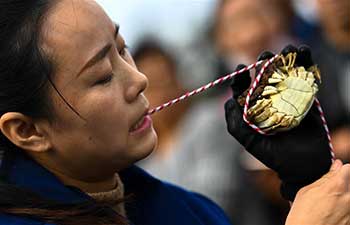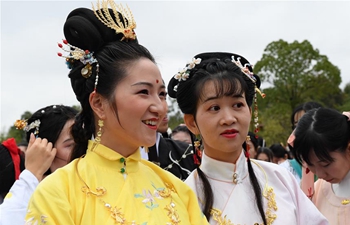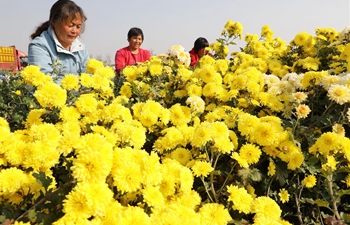NANNING, Nov. 4 (Xinhua) -- Instead of sleeping tight during the wee hours of the morning, Bi Decheng joins thousands of villagers in his hometown to harvest sweet corns in the cornfield, flashlights in hand.
"We harvest the sweet corns at 2 or 3 a.m. so that they can be delivered fresh to our customers at noon," Bi said, adding that he is expecting a good harvest as corns are ready for picking in November.
Bi is a sweet corn grower in Hengxian County, south China's Guangxi Zhuang Autonomous Region. The county is known as China's "home of sweet corns". Last year, a total of 260,800 tonnes of sweet corns were harvested from an area of 16,400 hectares. The area of corn plantation in Hengxian has ranked among China's biggest for more than a decade.
Bi lives in Qingtong Village, which churns out the biggest output of sweet corns in Hengxian, home to about 100,000 corn farmers. Bi has 133 hectares of sweet corn plantation in the locality, making him one of the biggest growers there.
Bi graduated from university in 2009 and returned to his hometown to cultivate sweet corns on a big scale. He mainly sells fresh corn, in addition to a series of spin-off products, including corn juice, corn wine and corn oil.
"In the past, corns were sold by the kilo, but now, as we pay more attention to the quality of corn, we sell them one by one," Bi said.
A single high-quality corn can rake in up to 10 yuan (1.5 U.S. dollars) each, and have been in high demand, he said.
"Even corn silk can sell for 100 yuan per kilo," he said.
Behind this sweet success is rising e-commerce. Beginning in 2016, local sweet corns were collected through rural cooperatives and were sold on e-commerce websites, said Xie Ziqiao, with the county's e-commerce management office.
"Corn products with source codes are particularly popular," Xie said.
With 569 million online shoppers, China saw its online retail sales shoot up to 4.08 trillion yuan during the first half of 2018. The mere scale of the online shopping population provides precious opportunities for the corn growers in the county.
According to local agriculture officer Long Zhaohui, every day, up to 2,000 tonnes of sweet corns are transported from Hengxian across the country, for both online and offline shopping.
"The corns are sold in northeast China's provinces, in northwest China's Xinjiang, and in metropolises like Beijing, Shanghai and Guangzhou, as well as in Hong Kong and Macao," he said.
The popular high-quality corns were made with scientific approaches, according to Bi Decheng. In Hengxian, most farmers take the cornstalks to feed cows after harvesting. The cows' waste is then used to help mushrooms grow, and the mushroom substrate is applied to cultivating sweet corns.
"It is a circular economy," Bi said.
In the past two years, locals have seen their lives prosper thanks to corn harvests. Villager Liu Weiwen said the stable prices of sweet corns have allowed him to buy a truck and a car, and even build two houses.
"Life is getting better these days," Liu said. "In our village, there are newly built roads, a basketball court and reading rooms, and we often dance in the 'sweet corn square'!"

















